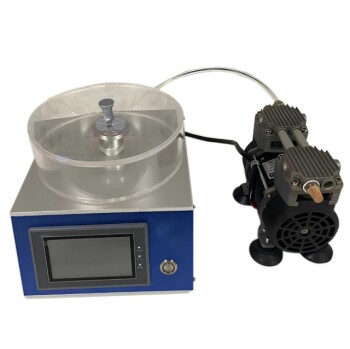At its core, a lamination machine works by using heat to activate a special adhesive on the inside of a plastic pouch. As the document and pouch pass through a set of rollers, pressure is applied, bonding the plastic to the item and sealing the edges to create a durable, protective covering.
Lamination is not merely about sealing a document; it's a thermal bonding process. The machine's primary role is to uniformly heat an adhesive to its melting point and then apply consistent pressure, ensuring a flawless, bubble-free bond that protects and enhances the item inside.
The Three Pillars of Lamination: Heat, Pressure, and Adhesion
To truly understand how a laminator functions, you must look at the three critical elements that work in concert. The machine itself is a tool designed to precisely manage this interaction.
The Lamination Pouch: The Key Ingredient
A lamination pouch is not just a simple plastic sleeve. It is a two-layer material specifically engineered for this process.
The inner surface is coated with a special extruded adhesive. This solid glue is designed to melt at a specific temperature.
The outer surface is a durable, clear plastic film (often polyester) that provides the structure and protection once the lamination is complete.
The Role of Heat: Activating the Bond
Inside every pouch laminator are heating elements, which are typically heated rollers or heat plates.
Their sole purpose is to raise the temperature of the lamination pouch as it passes through. This heat melts the adhesive, turning it from a solid into a viscous, tacky liquid.
Proper temperature is crucial. Too little heat results in a weak bond and a cloudy appearance, as the adhesive doesn't fully melt.
The Function of Rollers: Applying Uniform Pressure
The rollers serve two essential functions. First, they grip the pouch and pull it through the machine at a steady, consistent speed.
Second, and more importantly, they apply firm, uniform pressure across the entire surface. This pressure squeezes the molten adhesive into the fibers of the paper and eliminates any trapped air bubbles.
This combination of heat, followed immediately by pressure, is what creates the strong, clear, and permanent bond.
Understanding Common Lamination Failures
When the balance of heat and pressure is off, you will encounter problems. Understanding the cause is key to prevention.
Cloudy or Hazy Finish
This is the most common issue and is almost always caused by insufficient heat. The adhesive did not fully melt, preventing a clear bond from forming. Always allow your laminator to pre-heat completely.
Bubbles or Waves
Bubbles or a wavy finish indicate a failure in pressure. This can happen if the rollers are dirty or worn, or if the item is fed through the machine too quickly or at an angle.
Jamming and Wrapping
Jamming occurs when the pouch is fed improperly. If you feed the open end first, the molten plastic can ooze out and wrap around the hot internal rollers, causing a serious jam that is difficult to clear.
How to Apply This to Your Project
Understanding the principle helps you diagnose issues and improve your results. Your approach should depend on your primary goal.
- If your primary focus is durability: Ensure you are using the correct temperature setting for your specific pouch thickness to achieve a full, strong adhesive bond.
- If your primary focus is visual clarity: Allow the laminator to fully pre-heat before use and ensure your document is flat and free of moisture to prevent cloudiness or bubbles.
- If your primary focus is avoiding errors: Always feed the pouch using the pre-sealed edge first and ensure it is centered as it enters the machine.
By mastering this simple interplay of heat and pressure, you move from just using a machine to controlling a process for perfect results every time.
Summary Table:
| Lamination Component | Function & Role |
|---|---|
| Heat | Melts the adhesive layer inside the pouch to an active, liquid state. |
| Pressure (Rollers) | Applies uniform force to bond the plastic to the document and remove air bubbles. |
| Adhesive Pouch | A two-layer sleeve with a heat-activated inner coating that creates the permanent seal. |
Achieve flawless, professional lamination results for your laboratory documents, ID cards, and critical materials.
KINTEK specializes in providing reliable lab equipment and consumables. Whether you need a durable laminator for daily use or high-quality laminating pouches to protect important labels, instructions, or samples, we have the solution.
Contact our experts today to find the perfect lamination equipment for your laboratory's specific needs and ensure your documents are protected with a perfect, bubble-free seal every time.
Related Products
- Touchscreen Automatic Vacuum Heat Press
- Lab Plastic PVC Calender Stretch Film Casting Machine for Film Testing
- Double Plate Heating Press Mold for Lab
- Manual button battery sealing machine
- Automatic Heated Hydraulic Press Machine with Heated Plates for Laboratory Hot Press 25T 30T 50T
People Also Ask
- How does a hydraulic hot press machine work? Unlock Precision in Material Bonding and Forming
- Does hardening increase strength? Unlock the Key to Superior Material Performance
- What is a hot press used for? Bonding, Forming, and Transforming Materials with Precision
- What are hot presses used for? Transforming Materials with Heat and Pressure
- What does a hot press machine do? Permanently Bond, Form, or Transfer Materials with Precision




















